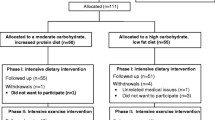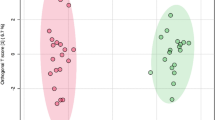Abstract
Impairment of insulin sensitivity of glucose metabolism, a prominent feature of type 1 diabetes (DM), is also well documented in adolescence and obesity. Overweight is frequently present during adolescence in females. Spurt in growth is significantly reduced during puberty in females with type 1 DM, while it is normal in males. In this study we assessed the effect of the coexistence of type 1 DM, adolescence, overweight, and their possible interference with growth. Moreover, we evaluated whether dietetic control associated with physical exercise improved insulin sensitivity in adolescence. The study enrolled 11 female adolescents and young adults (aged 18.5±0.6 years), affected by type 1 DM for 8.3±0.9 years, who were overweight (BMI, 27.3±0.8 kg/m2) and receiving conventional insulin therapy (0.78±0.10 U/kg day). We used the euglycemic hyperinsulinemic clamp technique coupled to [2H2]glucose and [13C]leucine infusion. The results show a striking increase in insulin resistance of glucose metabolism: the suppression of endogenous glucose production (EGP) was 59% in comparison to 90%–100% recorded by others at similar insulin levels in subjects at different periods of life. Insulin resistance in type 1 DM overweight adolescents was also present on protein metabolism: the postabsorptive plasma leucine (146.9±10.1 μM) and the endogenous leucine flux (ELF, 88.8±4.5 µmol/kg min) were higher than in healthy controls. The suppression of ELF during hyperinsulinemia was defective in diabetic adolescents (27%, p<0.001) with respect to controls (36%). Only three of the 11 overweight diabetic subjects completed the 6-month physical exercise and diet program, and showed improvement of insulin sensitivity at the final evaluation. The EGP suppression by insulin shifted from 41% to 79%; ELF suppression increased from 26% to 34%. All the parameters of glucose metabolism correlated with the weight loss (BMI reduction from 27.8±1.9 to 25.6±1.2 kg/m2). In conclusion, overweight female adolescents with type 1 DM have an impaired insulin action on glucose and protein metabolism. Physical exercise and correct dietary regimen positively influence insulin sensitivity. The present preliminary data are relevant for an improved control of glucose homeostasis and a normal growth in adolescence.
Similar content being viewed by others
Author information
Authors and Affiliations
Corresponding author
Rights and permissions
About this article
Cite this article
Luzi, L., Cavadini, V., Bognetti, E. et al. Insulin sensitivity of protein and glucose metabolism in overweight female adolescents with type 1 diabetes mellitus: positive modulation by physical exercise. Sport Sci Health 1, 41–46 (2004). https://doi.org/10.1007/s11332-004-0009-5
Received:
Accepted:
Issue Date:
DOI: https://doi.org/10.1007/s11332-004-0009-5




